And weird mystery insects.
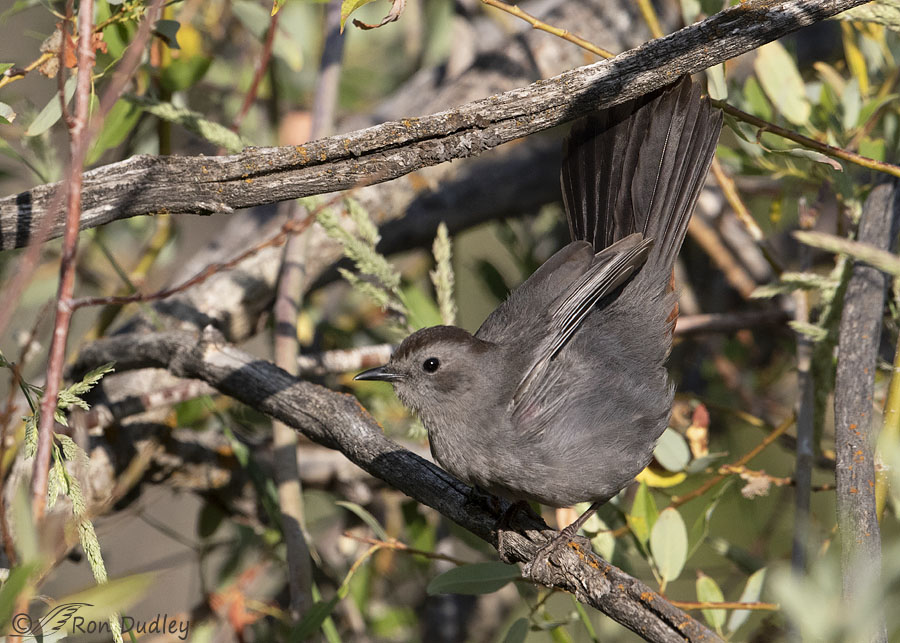
Yesterday morning in the mountains this Gray Catbird started acting up as soon as ‘he’ landed on this branch in a thicket. I knew immediately that he was reacting to another nearby bird, probably another catbird. He raised his tail and…
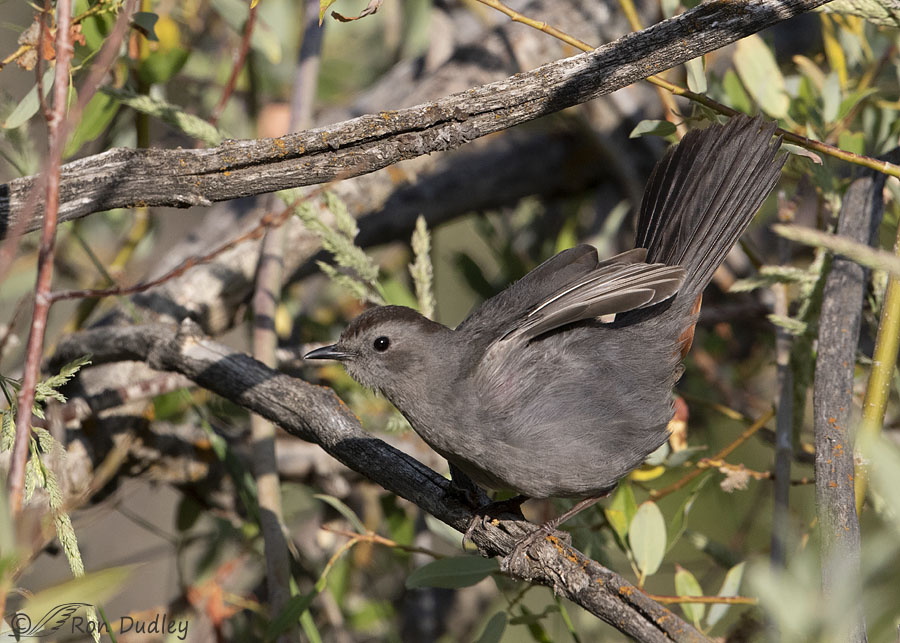
began to flutter his wings.
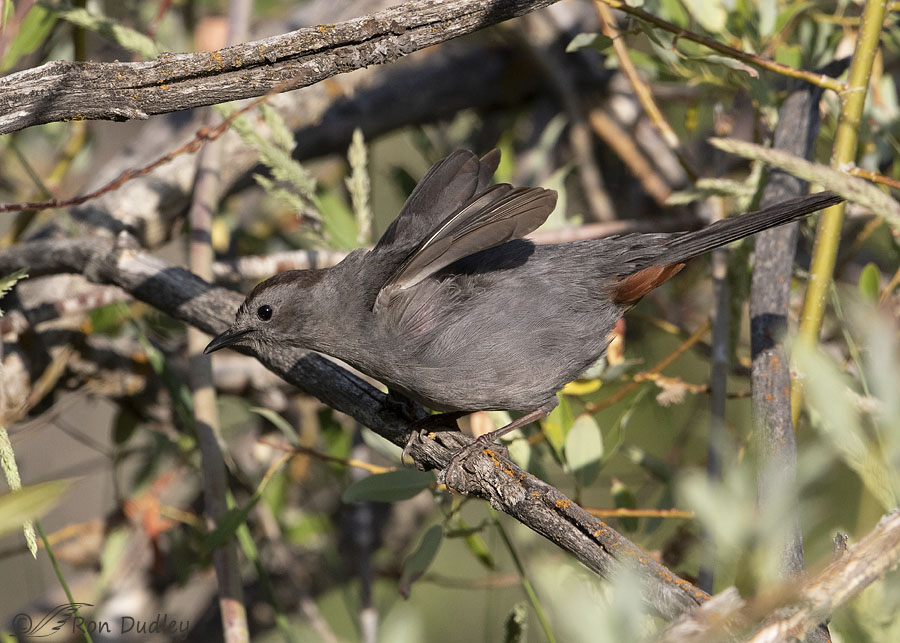
I could tell by watching the direction he was looking that the second bird he was so interested in was moving around in the thicket in front of and below him. Eventually he lowered his tail but he…
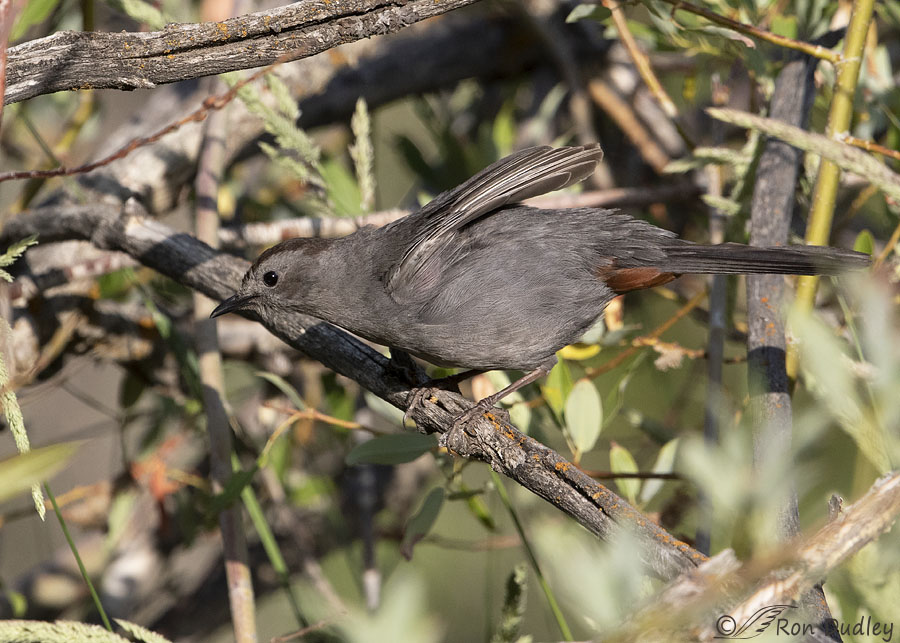
continued to flutter his wings as he watched the other bird.
Soon after this catbird flew off…
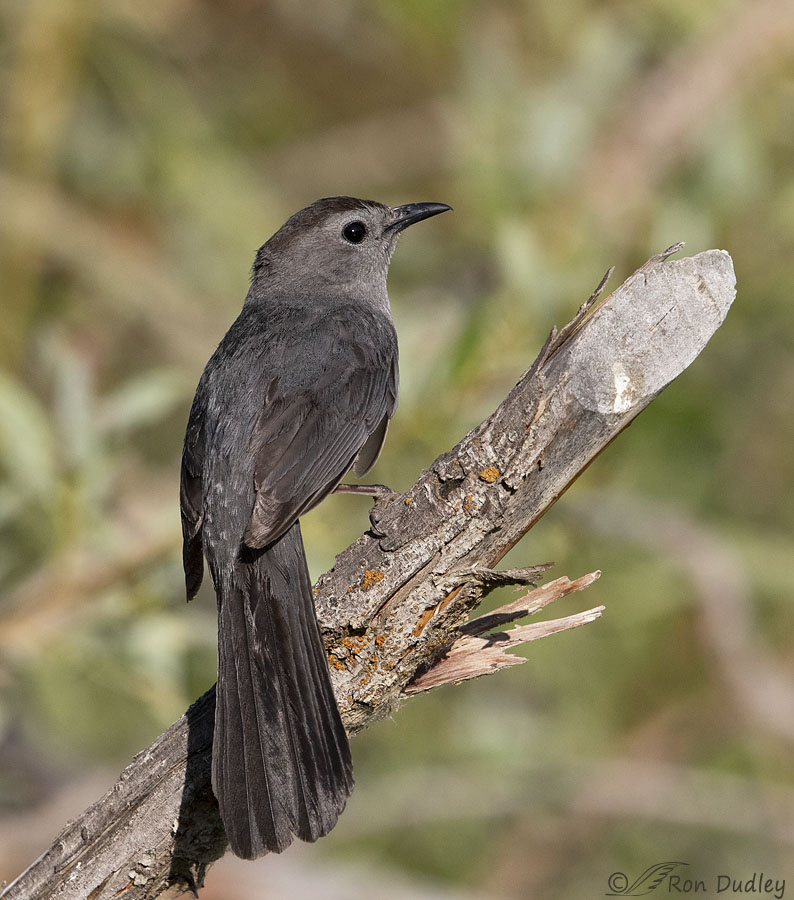
the second catbird came out of the thicket and landed on this stump quite close to where the first catbird had been displaying. I won’t even try to interpret the meaning of the interaction I witnessed but I do think it was interesting. And it allowed me to get this photo which I like a lot.
A little later that morning and a little further down the road I spotted some insects that have me both charmed and mystified.
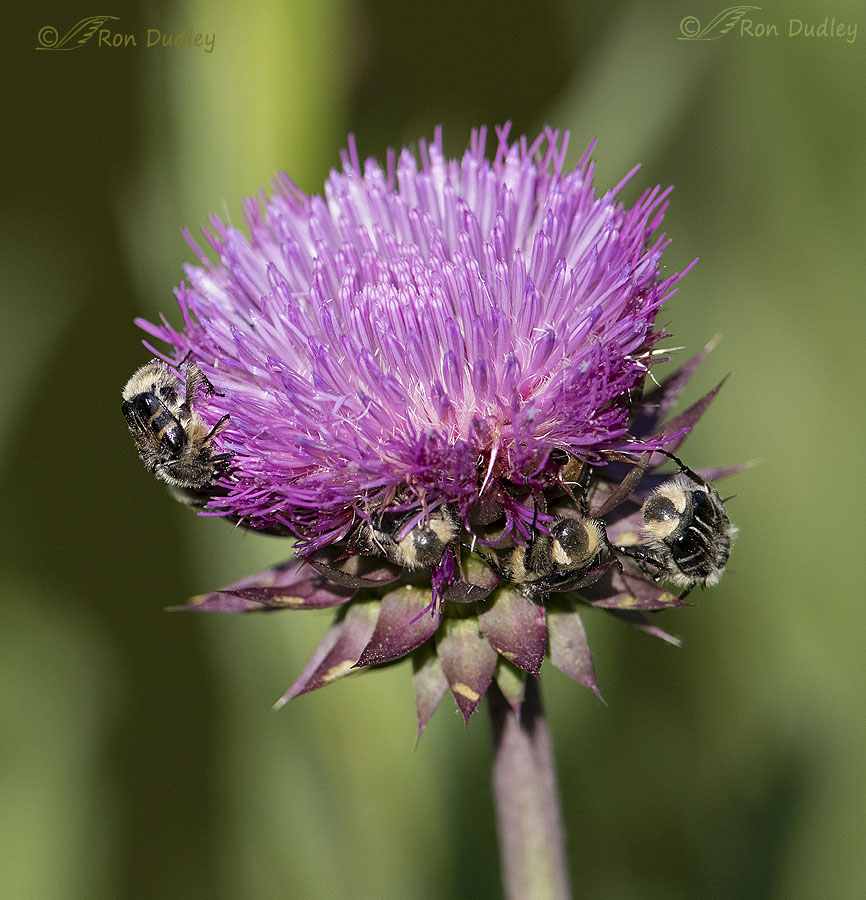
I’m not sure how many of them there were around the entire diameter of this Musk Thistle flower but most of them I could see were wedged head-first between the flower cluster and the bracts (modified leaves).
I thought they were cute as the dickens with their little bullseye butts sticking out but I have no idea why most of them were wedged into this unusual position. Most of the abundant pollen and nectar produced by thistles would be on and in the flower cluster rather than between the flower cluster and the bracts.
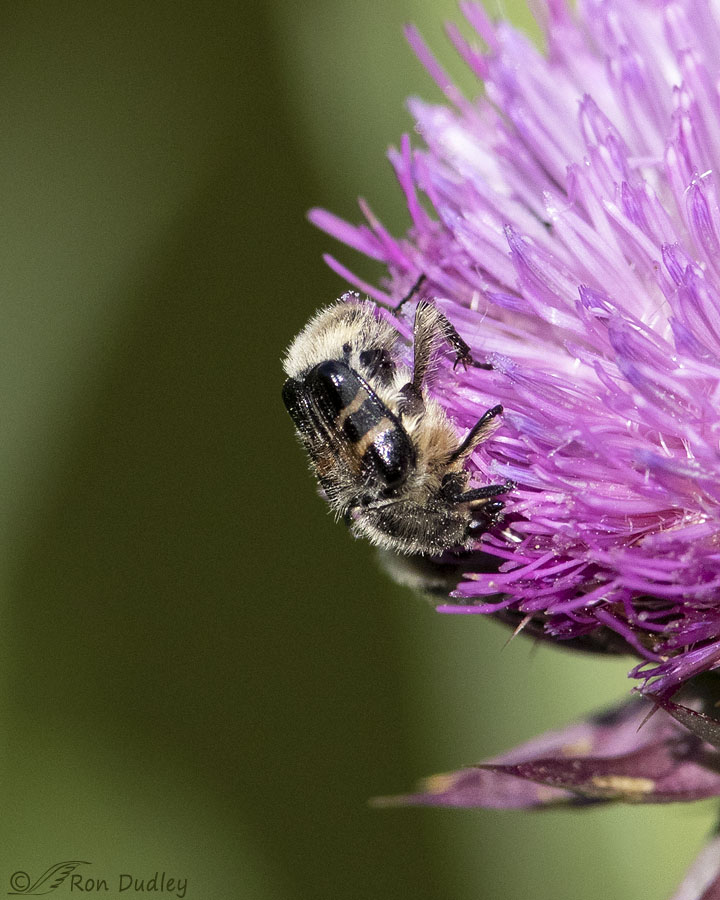
But what mystified me most was the anatomy of the insect itself. To my untrained eye they look like a cross between a bee and a beetle. Most of their characteristics seem bee-like to me, including the numerous hairs covering their bodies. But if they’re bees where are their wings?
Instead these insects appear to have beetle-like wing cases (elytra) forming a hard ‘shell’ over their backs that cover and protect the posterior pair of wings used for flight.
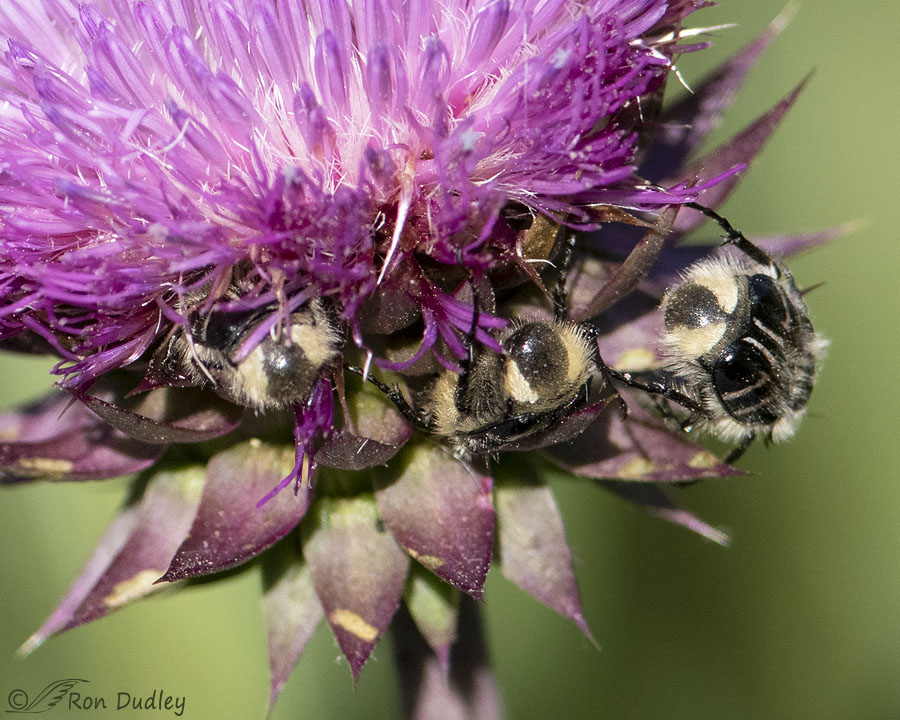
Here’s a closeup of the individuals that were wedged head-first between the flower cluster and the bracts. It also gives us another look, from a different angle, at the presumed wing cases of the insect on the right.
If I had to guess I’d say that these insects were attracted to the thistle by its abundant nectar and pollen and perhaps they spent most of their time foraging on the flowers like the individual on the left of the flower cluster. Maybe I just happened to come by while most of them were resting in a place on the thistle flower where they would be more protected from predators.
Whatever the case I’d sure like to know what kind of insects they are. Any thoughts?
Ron


In the first photo, I thought they looked like spiders. But so many in one place?
If it was very early in the day, the bee beetles may have still been sleeping in the flower bracts. Looks like a they could make a nice berth.
Your catbird photos are all very appealing (sometimes gray bird images can be kind of, well … dull) — I love their “Mohawk” cap and rusty butt. I’m thinking that wing fluttering was an invitation to “come closer, let’s have a better look at you” …. Perhaps the other was doing the same thing down in the thicket, so it really was a conversation?
I see iNaturalist (a great app!) calls your mystery creatures “bee-mimic beetles,” a most appropriate name. Thanks for noticing them and bringing them to our attention!
Thank you, Chris. Apparently quite a few species of beetles mimic bees but I’m still not finding any that look quite like these although Trichiotinus affinis suggested by Lyle comes pretty darn close.
Ron, here is a URL for iNaturalist Bee-like Flower Scarabs:
https://www.inaturalist.org/observations?place_id=any&subview=table&taxon_id=178762
Thanks, Tony. I’ll check it out.
Two treats this early morning.
And I adore both the catbirds and the fuzzy little bee-beetles. And was a tad surprised that none of your knowledgeable commentators have been able (yet) to definitely identify it.
I will watch this space.
EC, apparently this is a tough ID. I have hope.
Ron, they are beetles for sure. In the Scarab family, almost certainly, and I think some type of Flower Beetle.
I don’t know if you do iNaturalist at all, but that could start you down the road to ID.
No idea what the bees are, but love seeing your Catbird again. Very nice series.
Thank you, Everett.
Interesting “conversation” between the two Catbirds. Territoriality, friendly acknowledgment, just playing tag.
The beetles might be Trichiotinus affinis. I don’t see any maxillary palps, though.
Lyle, I looked at these photos of Trichiotinus affinis in this link:
https://en.wikipedia.org/wiki/Trichiotinus_affinis
I’m skeptical that that’s what I photographed.
What characteristic(s) are you seeing that do not fit the Trichiotinus affinis scarab beetle?
Pam, your question made me go back and compare them more carefully. They may not be as different as I thought they were at first. I’d now change “skeptical” to “maybe, but I’m just not sure”.
Perhaps that’s why I didn’t become an entomologist…
I love that you caught the russet butt of the catbird!
Interesting insect, you will have to post and update when you find out what they are. I will have to watch for them, however I am keeping my distance from stinging things!
“I am keeping my distance from stinging things”
April, given your recent history I don’t blame you one little bit!
Luv the Catbird of course. The bee/beetle IS a puzzle – I’ve never seen anything like that! Sure hope someone has the answer. The snuggling into the thistle flower is also interesting and something I’ve also never seen. “Continuing Education”.
The bee/beetle IS a puzzle – I’ve never seen anything like that! Sure hope someone has the answer. The snuggling into the thistle flower is also interesting and something I’ve also never seen. “Continuing Education”. 
“Continuing Education”
Yup, for all of us. Thanks, Judy.
Perhaps the catbird was worried about losing his seat (sorry, couldn’t resist).
Great shots, especially capturing the rusty butt feathers. I have no idea as to the insect ID (bee-tle?), but you sure do have quite the knack for finding interesting critters exhibiting interesting behaviors out there!
“Perhaps the catbird was worried about losing his seat”
There actually may be some truth in that, Marty. I figure there’s a good chance that this was an example of displacement, which is a pretty typical behavior for many bird species.
Mimicry — what a fabulous adaptation! It also looks like there may be a few species of bee beetle out there. I found this one as well. https://www.insectidentification.org/insect-description.php?identification=Bumblebee-Scarab-Beetle
Although the territory map doesn’t include Utah, we all know that insects can’t read maps.
Whoops! Meant to say Genera not species. (Gotta stop typing before I’ve had coffee!)
Yup, I’m thinking they are bee beetles. Sure be nice to know the species though…
I typed in bee beetle and the wonderful web led me to scarab bee beetle. Don’t know which species, but the description seems to fit the family anyway.
https://en.wikipedia.org/wiki/Bee_beetle
Thanks, Sarah. Bee beetles look like a likely candidate. Even though the ones I photographed apparently aren’t the same species as the one pictured in Wikipedia I’ll bet they’re related.
Love the catbird! I’m thinking the insects are one of the bee-imitating hoverflies, but which variety and why they’re arranged as they are is beyond my limited knowledge.
Robyn, but I don’t believe hoverflies have wing cases (elytra). The insects I photographed look like they do have them.
You might post it to https://bugguide.net/node/view/15740
Jo, I thought about doing that but I have a friend who used to post insect photos to various online insect ID forums and she almost never got any responses. So my friend no longer posts them.
Fascinating insects– I hope someone in your posse will recognize them
and give some info about them. What I like about truly curious people
( like you ! ) is that you’re not just looking FOR ( in this case, the catbird and its behavior )– but you’re much more broadly LOOKING, period, and so find
unexpected surprises–makes the world a much richer experience– far beyond
narrow expertise……thanks for your example !
Fascinating mystery and fabulous shots, esp the cat bird. I look forward to hearing if someone can identify the insect.
So do I, Pat. Thanks.
“makes the world a much richer experience”
I couldn’t agree more. Thank you, Kris.